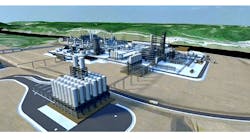Royal Dutch Shell NA’s (IW 1000/2) decision to build a major chemical plant in Pennsylvania boils down to a bet that North American shale gas in the next decade will remain cheaper than oil, the main petrochemical feedstock used in other regions. It’s a risk no one else has dared to take.
A barrel of Brent crude now costs about 20 times more than a million British thermal units of U.S. natural gas, a ratio that has shrunk from 60 times in 2012. As the continent’s cost advantage erodes, producers from Braskem SA to Chevron Phillips Chemical Co. are reluctant to commit to fresh investments after they complete a wave of new plants in the next couple years.
The hesitancy leaves few major projects in the pipeline after 2020 even as demand is expected to rise for such products as ethylene and polyethylene, which are used in plastic bags and bottles.
That’s contributing to a potential supply shortfall at the start of the next decade since chemical plants take five to seven years to complete, said Hassan Ahmed, an analyst at Alembic Global Advisors. Prices should rise without more production, boosting earnings -- and potentially doubling stock prices -- at chemical makers such as Dow Chemical Co. (IW 500/23) and LyondellBasell Industries NV, he said in a note Monday.
“After this first wave comes, people are paranoid about further additions because of all the volatility in energy,” Ahmed said in an interview. “We could see major under-investment, and that will keep markets tight.”
If you get into 2020 and you expand the lens beyond North America, you don’t see a whole lot of supply coming on."— Nova Chemicals CEO Todd Karran
Shell’s ethane cracker and polyethylene plants outside Pittsburgh would begin production after 2020, following a half-dozen similar projects on the U.S. Gulf Coast starting up through 2018. Shell said the factories will be built by about 6,000 construction workers and will employ 600 people when completed.
The company, which didn’t release an estimate of its investment, may spend $3.5 billion on the project, Ahmed said. The U.S. chemical industry has announced $161 billion of investments since 2010, said Kevin Swift, chief economist at the American Chemistry Council. The new plants will produce more than local markets need, sending excess supply abroad.
Shell’s announcement last week won’t push Braskem to pull the trigger on a similar project in nearby West Virginia, CEO Fernando Musa said in an interview at the chemistry council’s annual meeting in Colorado Springs, Colo. The plant, as well as a planned polypropylene factory in Texas, remains under consideration, he said.
Any decision requires the company to try to guess the future spread between oil and gas prices, Musa said. “Right now we are not comfortable on making that bet.”
Shale Wager
Braskem already has taken a $5 billion wager on North American shale gas: It is starting up new ethylene and polyethylene plants in Mexico whose ethane feedstock price is linked to the benchmark at Mont Belvieu, Texas.
Chevron Phillips plans to start production next year at an ethylene and plastics complex outside Houston that will cost $6 billion. The company isn’t ready to commit to a planned second “megaproject,” Chief Executive Officer Pete Cella said in an interview at the industry conference in Colorado last week.
“The folks that are running light feeds like us have seen some compression in our margins,” Cella said. “That has to give people some reason to step back and think much harder about where supply and demand for all the energy constituents are going before you move forward on a major investment.”
BASF SE, the world’s largest chemical company, this month postponed a decision on whether to build a 1 billion-euro ($1.13 billion) plant in Texas that would convert methane to propylene, its biggest ever investment in a single facility, partly in response to volatile raw-material prices.
North American profit margins for making ethylene and polyethylene plastics are still among the best in the world, albeit off their peaks. The first wave of new North American plants may create some downward pressure on prices by increasing supply, but the excess will quickly be consumed by global demand that grows by the equivalent of three to five large ethylene plants every year, said Nova Chemicals CEO Todd Karran.
Not everyone is so bullish on basic chemicals. Charles Neivert, an analyst at Cowen & Co., on Monday downgraded LyondellBasell to market perform from outperform in part because he expects increased capacity and higher ethane prices to pressure margins.
Nova will decide next year whether to expand its ethylene plant in Corruna, Ontario, by 50%, he said.
“If you get into 2020 and you expand the lens beyond North America, you don’t see a whole lot of supply coming on,” Karran said in an interview. “But demand keeps ticking along.”
By Jack Kaskey



